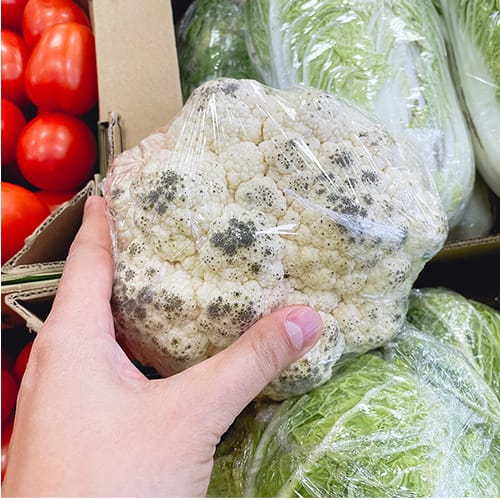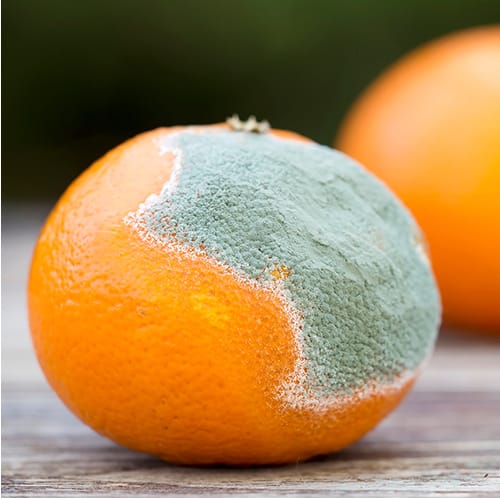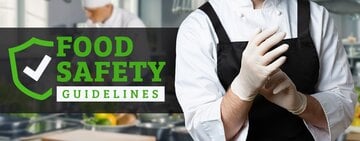
Moldy food is a problem faced in countless kitchens. It can ruin your bulk ingredients and disrupt your menu planning. Not only should operators know how to handle moldy food and when to dispose of it, but they should also know how to properly use their food storage supplies and how to keep food from getting moldy in the first place. By taking proactive steps to prevent mold from growing, you can uphold food safety standards in your kitchen.
Shop All Sanitizing and Disinfecting Chemicals
Why Does Mold Grow on Food?

Mold grows on food when it is given the right environment to spread. If one or more of the following environmental conditions are met, you may be more likely to encounter it in your kitchen.
- Presence of mold spores: Mold spores are microscopic organisms that can be found floating in the air and will quickly attach to various surfaces or substances, including your food. Once they germinate, they will grow into mold.
- Excess moisture: Mold grows best in moist environments, as it requires water to grow. Keeping your kitchen well-ventilated, ensuring your exhaust hoods are clean and working efficiently, and running a dehumidifier can help prevent mold growth in a humid setting. Foods that retain moisture or haven't been cooled properly are also more susceptible to mold growth and should be properly stored to prevent contamination.
- Nutrients: Foods that are rich in sugars or acids provide mold with the necessary nutrients to spread. Because of this, fruits, vegetables, and baked goods are particularly susceptible.
- Temperature: Mold tends to thrive in warm temperatures rather than cold ones. Storing dry goods in a cool, dry place and refrigerating cooked or temperature-sensitive foods can mitigate the risk of growth.
Methods of Preventing Mold on Food
Preventing mold on food is a tricky process, as there isn't one direct method to keep it from growing. However, there are a series of best practices you can follow to minimize the risk of mold growth in your commercial kitchen and keep your food safe. By adhering to these tips, you should be able to operate with peace of mind and prepare your signature foods with confidence.
1. Always Wash Fresh Produce

Unwashed produce may retain mold spores, bacteria, or organic material from the field. Since many of these foods are high in sugar content, they provide the perfect environment for mold to spread, especially if they are grown in a humid area. For that reason, all fresh or incoming produce should be washed under running water and air dried thoroughly. If the product must be dried immediately, you can use a paper towel. Additionally, leafy greens that must be dried immediately can be dried using a salad spinner. Ensure that you store this food in the corresponding spot in your refrigerator to extend its shelf life and minimize the risk of mold growth. Fruits and vegetables that tend to grow mold the fastest include those with thin skin, which allows spores to easily access their nutrients, such as the following:
- Blackberries
- Raspberries
- Strawberries
- Tomatoes
- Bell peppers
2. Regularly Clean Your Kitchen
Even if your kitchen looks clean, it may still harbor the right conditions for mold growth. Naturally, a busy kitchen can accumulate grease and grime, so you should take extra care to clean and sanitize the space. Setting up a routine cleaning schedule is essential, not only for the visible areas of your kitchen, but also for your stockroom and walk-in refrigerator. These areas can often be overlooked, but can harbor bacteria or organic materials that may cause the spread of mold.
In addition to regular cleaning, you must have a dedicated process for disposing of moldy food. This ensures that contaminated food is not accidentally used in a dish or kept in your stock room, which could lead to health risks for your customers.
3. Store Food Properly in the Refrigerator
While storing food in a refrigerator keeps it cool, improper storage can still promote germination in mold spores. To ensure that your refrigerated foods remain mold-free, follow the first in, first out (FIFO) method of food storage, ensuring that items are used before they have the chance to spoil. When storing hot foods in the refrigerator, place them near the top shelf in shallow, covered containers. Regular cleaning and sanitizing of your refrigerator are also essential in preventing mold. Use a clean cloth, sponge, and cleaning solution on the interior to eliminate any stuck-on spores or bacteria.
4. Don’t Let Food Sit Out
When you get a new shipment of inventory, whether it’s meat, produce, or dry goods, you must put it in the proper storage area as soon as possible. Fresh foods that are suitable for room temperature conditions typically only on the counter for a few days before showing signs of spoilage. Fresh produce might contain contaminants that could spread throughout your kitchen, while meat left out too long will be at an increased risk of growing mold or spoiling. Your dry goods should be put in the pantry or storage room as soon as possible, as your busy kitchen might lead to the transfer of mold spores or bacteria.
5. Let Foods Cool Before Storage
Cooling foods properly before storage is especially important for soups, baked goods, and any hot foods that produce steam. Allowing these items to cool before placing them in the refrigerator not only prevents your refrigerator from getting too hot but also helps reduce the risk of condensation buildup. The cooling methods you use may vary depending on the type of dish you are preparing.
- Soups and liquid dishes: For soups and liquid dishes, consider using ice cubes or cooling paddles for quick and efficient cooling. These tools help lower the temperature of the food rapidly, reducing the time it spends in the temperature danger zone.
- Baked goods: Remove baked goods from their tin or baking mold as soon as possible. By doing so, you can help reduce heat transfer, allowing the baked goods to cool more evenly and quickly.
- Batch meals: Store any bulk items or batch meals in shallow containers to promote quick and even cooling. The deeper the dish, the longer it will take to cool down to a safe level.
6. Manage Your Stock
To effectively manage your stock, keep track of when items arrive and store them using the FIFO method, just as you would in the refrigerator. The oldest items should be towards the front of the shelves, with newer items towards the back. This ensures items are used in the order they were received, minimizing the risk of food spoilage and mold development and keeping mold spores from spreading further throughout your facility. Remember, the longer food sits, the older it will get, and the more likely it is to develop mold.
7. Maintain Consistent Ventilation and Airflow
For dry goods that aren't stored in the refrigerator, airflow and ventilation are critical. If air isn't properly ventilated, it will be more likely to accumulate mold spores or moisture, and as such, your food will be more likely to mold over time. If your space is prone to moisture, invest in commercial dehumidifiers. Additionally, if you want to reduce the risk of airborne contaminants entering your space, install air curtains on your doorways for extra protection.
Food Mold FAQ

It is crucial to stay informed about food mold to ensure the safety and quality of your products. In this section, we will address some of the most common questions related to food mold to help you make informed decisions and mitigate its growth and spread.
How Fast Does Mold Grow on Food?
Depending on conditions related to storage and environment, mold can become visible on food within 3-12 days. However, what is often overlooked is that mold can germinate in as little as 24 hours.
What Does Mold Look Like On Food?
Understanding what mold looks like on food is crucial for maintaining food safety standards in a commercial setting. Keep a close eye on your food products to ensure that any signs of mold are promptly addressed. Mold may appear on your food in the following forms:
- Fuzzy patches
- Dust
- Spots
- Discoloration
Mold can range in color from white to green, black, and even pink. The exact color and texture of mold will depend on the type of food you are examining and how it was stored.
What Temperature Kills Mold Spores on Food?
While most mold spores are killed at any temperature above 140 degrees Fahrenheit, it is recommended that you expose food to temperatures between 140 and 160 degrees Fahrenheit to fully eliminate spores. This range ensures that the heat penetrates the food thoroughly, reaching all areas where mold spores may be present. It's important to note that simply cooking food at high temperatures may not always guarantee the complete eradication of mold spores. To ensure thorough elimination, it is essential to follow proper food handling and storage procedures. If there are any signs of spoilage or mold spores on food, they should not be used or served in commercial settings.
Back to Top
By understanding the fundamentals of food mold and following best practices for food safety and storage, you can maintain the quality of your products and protect the health of your customers. Stay informed, take preventative measures, and prioritize food safety to minimize the risks associated with moldy food in your kitchen.





